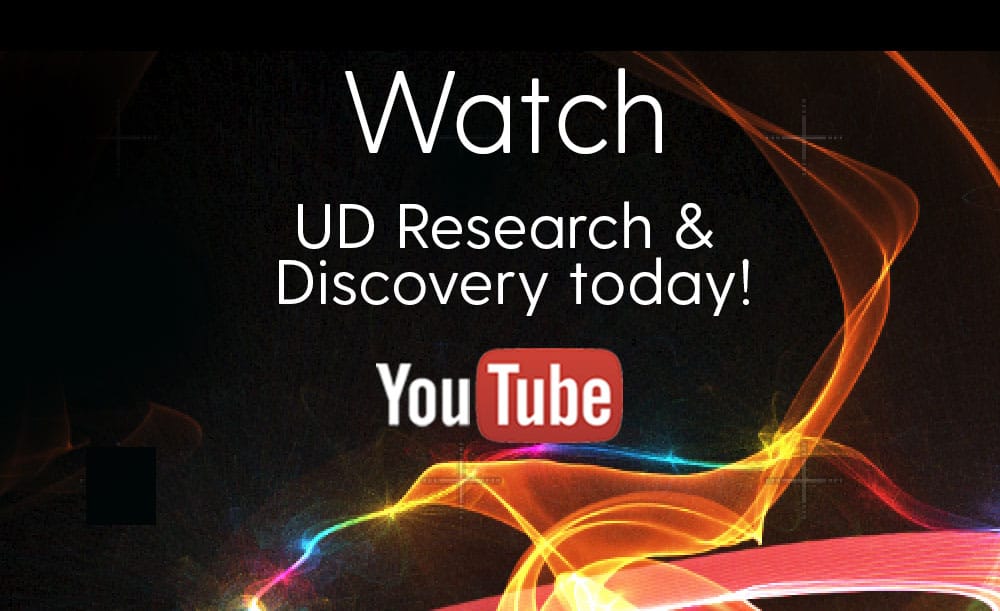RESEARCH
DISCOVERY
A Blog Devoted to UD Innovation, Excellence & Scholarship
COVID-19
Finding a Silver Lining
University of Delaware Associate Professor Michelle Cirillo (right) interviews undergraduate Kayla Hurst about her preservice teaching experience that moved from in-person to online during the 2020 spring semester, due to the coronavirus pandemic.
When the coronavirus (COVID-19) prompted the closure of schools, impacting the field experience of University of Delaware students enrolled in teacher preparation programs, researchers Michelle Cirillo and Raymond LaRochelle jumped into action. They made sure a group of secondary math education students learning to teach in a 100-level University math class continued to polish their skills, despite the move to online learning.
Cirillo, an associate professor in the Department of Mathematical Sciences with a joint appointment in the College of Education and Human Development, and LaRochelle, a postdoctoral researcher in the department, worked with math instructor Tammy Rossi to consider how the preservice teachers could remain involved remotely.
The research team decided to have the student teachers facilitate small-group student discussions in virtual Zoom breakout rooms and provide support for problem sets that followed the course instructor’s lessons. The future educators would focus each week on practicing specific teacher discourse moves and reflecting on how it went in an assignment for a teaching methods course they were taking in tandem with LaRochelle. The online field experience wouldn’t be exactly the same, but they hoped it would still be beneficial for all involved.
As the plan was coming together, Cirillo realized that the unusual circumstances presented an opportunity to evaluate the effectiveness of an online-teaching field experience in comparison to the one typically executed in an on-campus classroom setting. Specifically, this situation was unique in that the researchers could study two groups of students who experienced in-person and online teaching with the same instructor, in the same course, during the same semester. Typically, making these kinds of comparisons would require control and experimental groups; and such comparisons have their limitations.
The researchers interviewed the preservice student teachers, the math students enrolled in the pre-calculus course serving as the site for the field experience, and Rossi about how things were going, shortly after returning from the extended spring break and again at the end of the semester.
Early results of the National Science Foundation (NSF) supported math education study — published in a paper in the Journal of Technology and Teacher Education — provided some interesting clues as to what undergraduates need and value in preparing for their student teaching placements.
The UD early field experience for secondary math education students grew out of a model developed by Cirillo’s colleague Kristen Bieda, an associate professor of mathematics education at Michigan State University, and later piloted at UD by Cirillo and at Pennsylvania State University by her colleague Fran Arbaugh. The university teaching experience model (UTE), coordinated through UD’s Mathematical Sciences Learning Laboratory, aims to unify the experience of preservice teachers so that they have a stronger foundation when they head into the community for their first student teaching placement.
The idea is to provide future educators a common classroom context and experience where they can work on lesson plans, facilitate small-group discussions, observe their instructor and peers, and often facilitate their first lesson with an actual class.
Cirillo described the class as a “kind of safe space with lots of support that allows them to practice teaching,” while the education methods class, which the students take concurrently, provides specific techniques for actually learning to teach.
During a typical semester, the preservice teachers enrolled in this course attend class and work with a group of math students in the classroom. They also plan and teach two activities, a 15-minute and then a 30-minute activity, to the pre-calculus class to gain experience. When the spring 2020 class moved online, the preservice teachers instead worked on problem sets with math students week-to-week in Zoom breakout rooms and focused on honing a specific teaching skill — facilitating mathematical discussions.
The research team’s findings revealed that preservice teachers missed having the opportunity to see the instructor, Rossi, teaching live in a classroom setting, where they could watch both what the professor taught and how it was interpreted or experienced by the math students.
“I’d never heard this as a benefit of the UTE model in the two years we’ve been studying this, but when it was taken away, the preservice teachers’ comments showed how important it was to observe the live instruction and Rossi’s effective student interactions,” Cirillo said. The preservice teachers also expressed disappointment at having to write lesson plans that they would never deliver in person, another important insight since many students who become teachers engage in this practice in other courses.
That said, it was clear that the preservice teachers were a valuable part of the classroom, whether class was conducted in person or online.
“The math students were ecstatic when they logged into their small breakout Zoom groups and discovered that the preservice student teachers continued to be part of the class and were available for questions,” said LaRochelle, adding that many students said they would recommend being in a section with preservice teachers to their friends.
The Zoom breakouts were recorded, allowing the preservice teachers to review and reflect on their interactions as an assignment for their education methods class with LaRochelle.
“Because the Zoom breakouts were recorded, I was able to watch the video recordings, read the preservice teachers’ reflections and offer feedback, unpacking which parts of a particular move the future teachers got right and illuminate things they were missing,” said LaRochelle. “It created an interactive dialogue that helped the students improve or consider other ways of doing things in the future.”
Though it was a bit more work for the instructor, LaRochelle called it “incredible, uplifting, energizing” and said having this feedback week-after-week created a more personalized experience for the future teachers. The preservice students reported finding it particularly helpful to learn the names of the discourse moves and to be able to reflect on what happened when they tried to execute various discourse moves for the first time.
“According to the student interviews, the opportunity to reflect on the use of these moves within their small groups was so beneficial that I want to think about a way to incorporate that activity into the field experience when we go back to campus,” said Cirillo.




